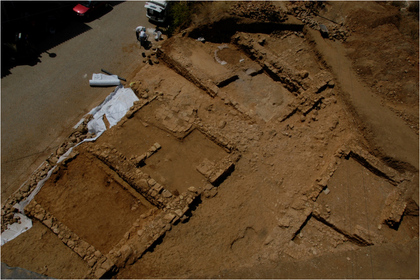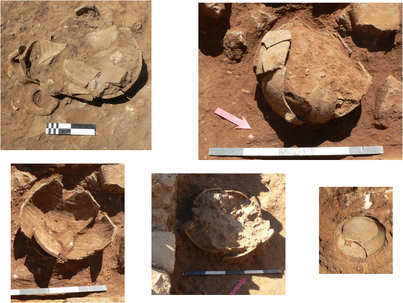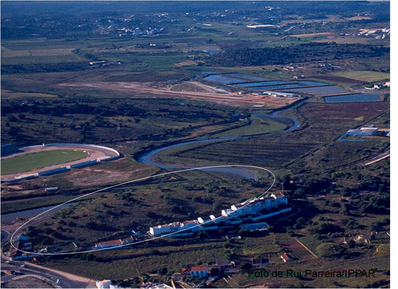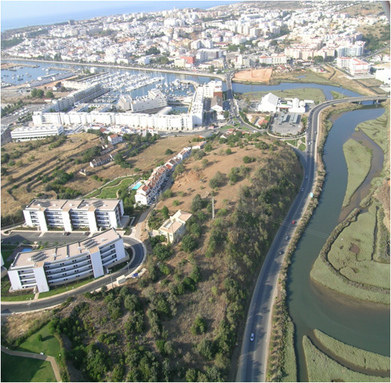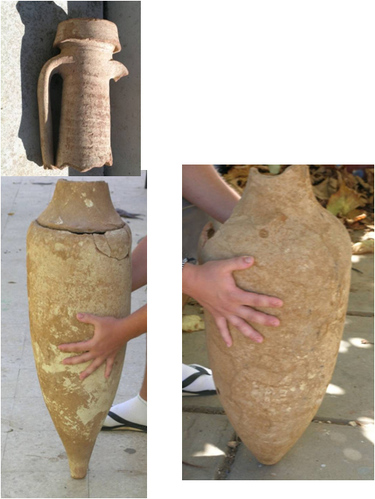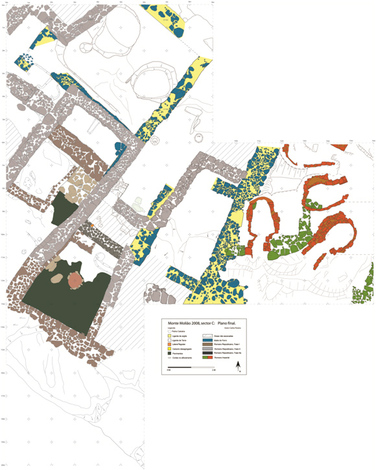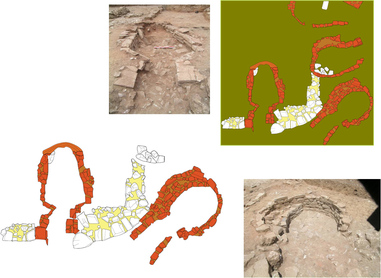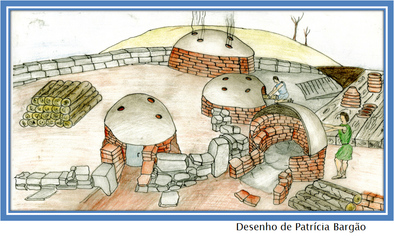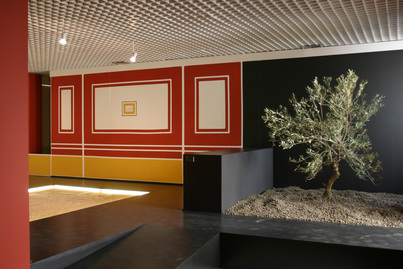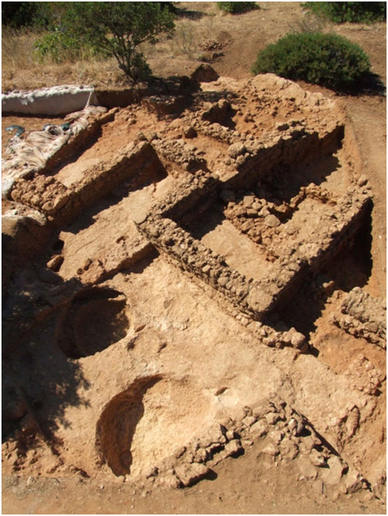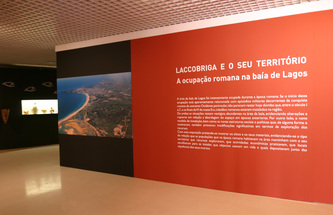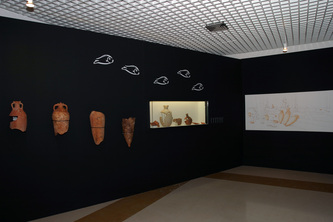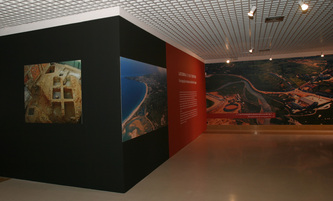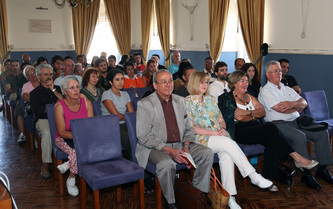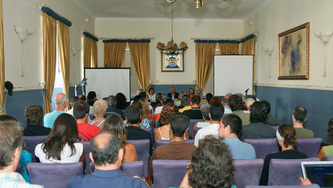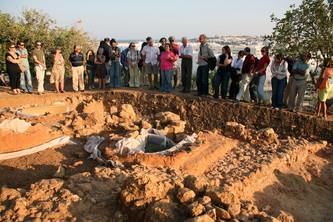Monte Molião (Lagos)The research project currently developed at Monte Molião stemmed from a partnership set up in 2006 by the Lagos City Council, the School of Humanities of Universidade de Lisboa and UNIARQ. The importance and meaningfulness of the site, often identified as Pomponius Mela’s Laccobriga, required a series of actions aimed at properly assessing the timeframe of its occupation, as well as the state of preservation of its archaeological remains.
Ten years of fieldwork, plus a few years of lab research, yielded new important data on the site’s occupation in the context of the Lagos bay, making it possible to broaden the knowledge previously compiled by Estácio da Veiga, Santos Rocha and Leite de Vasconcellos. Founded in the late 4th century BCE, Monte Molião had a strong connection with the Cadiz area, evidenced by imports of food and manufactured products and an “stone-cave” architecture characterized by systematic carving of the bedrock that finds its best parallels in the south of Western Andalucía. The Repubican Roman Period is also well documented, namely by housing structures and archaeological remains. As regards the latter, imports from Italy (e.g. amphorae, campanian wares, and thin-walled pottery) did not set aside Cadiz products, which remained significant. The Imperial Roman Period is well represented by the Julian-Claudian and Flavian dynasties, with housing and industrial structures – the latter used for producing containers (made of common wares and destined for fish-processed products). Other structures were built in the late 1st century/early 2nd century AD, on top of the structures of the previous period, and abandoned around the mid 2nd century AD. Research on this site has been based on the analysis of many tenths of thousands of archaeological pieces (ceramics, metal, glass and bone) and other remains (namely fauna). The project has already yielded four Master’s Theses and several published papers, with other works in print. Master’s Theses Pedro Lourenço «Fisheries at Monte Molião». Faculdade de Letras da Universidade de Lisboa. Discussed and approved, with a classification of 80 per cent. Vanessa Dias «Bell-Beaker ceramics at Monte Molião» Faculdade de Letras da Universidade de Lisboa. Discussed and approved, with a classification of 90 per cent. Álvaro Pereira “African cooking ceramics from Monte Molião (Lagos)” Discussed and approved, with a classification of 80 per cent. Giovanni Muccoli The coin collection of Monte Molião (Lagos, Portugal) Discussed and approved, with a classification of 85 per cent. Published papers 1. Arruda, A. M. (2007), Laccobriga: A ocupação romana da Baía de Lagos. Lagos: Câmara Municipal. PDF Arruda 2007c 2. Arruda, A. M, Sousa, E., Lourenço, P. Bargão, P. (2008), Monte Molião (Lagos) – Resultados de um projecto em curso. XELB, 8, p. 161-192. PDF Arruda et al. 2008 3. Arruda, A. M. e Pereira, C. (2010), Fusão e produção: actividades metalúrgicas em Monte Molião (Lagos), durante a época romano-republicana. Xelb, 10, p. 695-716 PDF Arruda, Pereira, 2010 4. Arruda, A. M., Viegas, C. e Bargão, P. (2010), A cerâmica comum de produção local de Monte Molião. Xelb, 10, p. 285-304 5. Arruda, A. M., Sousa, E. e Lourenço, P. (2010), A necrópole romana de Monte Molião (Lagos). Xelb, 10, p. 267-283 6. Arruda, A. M. ; Sousa, E. (2012) - Ânforas republicanas de Monte Molião (Lagos, Algarve, Portugal), In SPAL, 21, p. 93-133 PDF Arruda e Sousa 2012 7. Arruda, A. M.; Pereira, C. (2012) – De Santa Olaia a Bensafrim: itinerários e percursos de Santos Rocha no Algarve. In R. Vilaça e S. Pinto (Org.) Santos Rocha- A arqueologia e a sociedade do seu tempo. Figueira da Foz: Casino Figueira, p. 133-151. 8. Arruda, A.M. (2012) – Monte Molião. In J. Alarcão; M. Barroca (Eds.) Dicionário de Arqueologia Portuguesa. Porto: Figueirinhas, p. 237-238. 9. Detry, C.; Arruda, A.M. (2012) - Acerca da influência ambiental e humana nos moluscos de Monte Molião (Lagos, Portugal). In A. Campar Almeida, A. Bettencourt, D. Moura, S. Rodrigues e M. I. Alves (Eds.) Environmental changes and human. Interaction along the Wester Atlantic edge. Coimbra: Associação Portuguesa para o Estudo do Quaternário, p. 171-184. 10. Detry, C.; Arruda, A. M. (2013) – A fauna da Idade do Ferro e época romana de Monte Molião: continuidades e rupturas na dieta alimentar. Revista Portuguesa de Arqueologia. 16, p, 213-226. 11. Gomes, F.; Arruda, A.M. (2013) – A cerâmica pintada da II Idade do Ferro do Castelo de Castro Marim. Onoba. Huelva, 1, p. 19-54. 12. Sousa, E. e Arruda, A. M. (2013) – A cerâmica de tipo Kuass de Monte Molião (Lagos). In Arqueologia em Portugal, 150 depois. Actas do I Congresso da Associação dos Arqueólogos Portugueses. Lisboa, p. 651-660. 13. Viegas, C. e Arruda, A.M. (2013) – Ânforas romanas de época imperial de Monte Molião (Lagos): as Dressel 20. In Arqueologia em Portugal, 150 depois. Actas do I Congresso da Associação dos Arqueólogos Portugueses. Lisboa, p. 727-735. 14. Sousa, E. e Arruda, A. M. (2014) - A cerâmica comum romano-republicana de Monte Molião (Lagos). Onoba, 2, p. 55-91. 15. Arruda, A. M.; Sousa, E.; Pereira, C.; Lourenço, P. (2014)– Monte Molião: um sítio púnico-gaditano no Algarve (Portugal). Conímbriga, 50, p. 5-32. 16. Sousa, E. e Arruda, A. M. (2014) - Italics and Hispanics in south-west Iberia at the dawn of the Roman-Republican period. The common ware of Monte Molião (Lagos, Portugal). In Rei CretariÆ RomanÆ FaVtorVm. Acta 43, p. 663-670. 17. Viegas, C.; Arruda. A. M. (2014) – A cerâmica de cozinha africana e as suas imitações em Monte Molião (Lagos, Portugal). In R. Morais; A. Fernandez; M. J. Sousa (Eds. Científicos) – As produções cerâmicas de imitação na Hispania. Porto: Faculdade de Letras. Monografias Ex Officina Hispana II, p. 249-260. 18. Arruda, A. M.; Gomes, F. (2015 [2013]) – O Monte Molião (Lagos), no Baixo Império: um epifenómeno. Conimbriga, p. 147-164. 19. Arruda, A. M.; Viegas, C. (2016) – As ânforas alto-imperiais de Monte Molião. In R. Járrega e P. Berni (Eds.) – Amphorae ex hispania: paisajes de produción y consumo. Tarragona: Instituto Catalán de Arqueologia Clásica, p. 446-463. 20. Arruda, A. M.; Pereira, A. (2017) - A cerâmica de cozinha Africana de Monte Molião (Lagos, Portugal) e o seu enquadramento regional. Onoba, 5, p. 21-43. ISSN: 2340-3047 Divulging the scientific work to a non-specialist audience has always been a priority. Among such actions, special reference should be made to the exhibition Laccobriga, which remained open to the public between March and December 2007 at the Lagos Cultural Centre. We should also mention the Open Day Actions, held in 2007, 2008, 2009, 2014, 2015 and 2017, when the site was open to visitors, and children were involved in playful-pedagogic activities. Project researchers also made presentations based on results from fieldwork. |
